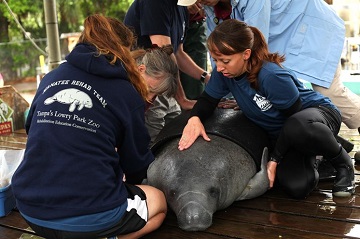Scientists puzzled by Manatee deaths on Florida's east coast.
 Even as a Red Tide algae bloom is wiping out a record number of manatees in southwest Florida, a mysterious ailment is killing dozens more manatees on the state’s east coast. So far, state biologists have been unable to pinpoint the cause.
Even as a Red Tide algae bloom is wiping out a record number of manatees in southwest Florida, a mysterious ailment is killing dozens more manatees on the state’s east coast. So far, state biologists have been unable to pinpoint the cause.Pat Rose, a former government manatee biologist who is now executive director of the Save the Manatee Club, said he could not recall another time when manatees were being killed in such numbers on both coasts at the same time.
Since last July, 55 manatees showing similar symptoms have died in the Indian River Lagoon area — 25 in just the past month, according to Kevin Baxter, a spokesman for the state’s Fish and Wildlife Research Institute in St. Petersburg.
There is no Red Tide bloom on the east coast, and the winter has not been cold enough to kill manatees. So far, Baxter said, no sick manatees have been rescued, availing biologists with a live specimen to study for clues.
They suspect the manatee deaths may be connected to back-to-back blooms of a harmful algae, one that has stained the Indian River Lagoon a chocolate brown. Over the past two years the blooms wiped out some 31,000 acres of sea grass in the 156-mile-long lagoon that stretches along the state’s Atlantic Coast. Manatees eat sea grass, but with the sea grass gone, they may have turned to less healthful sources of nutrition.
“A big part of it is that there’s just not that much left for them to feed on,” Rose said. “The system is way out of balance.”
The manatees that have turned up dead on the east coast all appeared to have gone into shock and drowned after they “ingested large amounts of macroalgae,” Baxter said. “Our researchers are thinking the deaths are related to some kind of dietary change.”
This is not the only mystery that state biologists are trying to solve. Last week they announced that, since the start of 2013, more than 100 brown pelicans have been found dead in that same area of Brevard County. The pelicans were emaciated and full of parasites. So far biologists don’t know what killed them or if there could be any connection with the dead manatees.
Rose blamed the Indian River Lagoon’s toxic algae blooms on nutrient pollution from storm runoff. The runoff carries into the waterways excess fertilizer, sewage and animal waste that fuels the growth of some algae.
Although scientists suspect something similar fuels Red Tide blooms too, they lack the evidence to prove it. Red Tide, an algae bloom that turns the water the color of rust and releases toxins that can prove fatal for fish, dolphins and manatees, has killed more than 180 manatees so far this year in Lee County. That breaks the 1996 record of 151.
State biologists estimate the total Florida manatee population to be between 4,000 and 5,000. Manatees have been on the federal endangered species list since the list was created in 1967. They have been protected by state law since 1893.
You can return to the main Market News page, or press the Back button on your browser.

